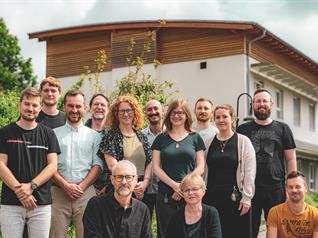 Back to the homepage of the research area
Back to the homepage of the research area
Contribution to ZALF research
Comprising six working groups at present, Research Area 1 “Landscape Functioning” is performing knowledge-oriented research on deepening our understanding of processes, cause-and-effect relationships and causal chains as well as the interactions within and among the different landscape elements such as cropland, grassland, waterbodies and forests. In this context, memory effects must also be considered, i.e. mid- to long-term effects of previous actions or interventions in agricultural landscapes. Research activities in Research Area 1 include the detection and analysis of new phenomena, the continuous improvement and development of research methods as well as the analysis of process dynamics by coupling data with models.
The aim of our research is to improve the understanding of biogeochemical cycles (carbon, nitrogen, silicon) and their driving forces (soil, plants, microorganisms) in agricultural landscapes. This is where the research of our individual working groups is interlinked. The results are incorporated into the development of sustainable land management systems, as it is being done in Research Areas 2 and 3. For cross-scale research questions, Research Area 1 works closely with the Research Platforms
“Data“ and
“Models & Simulation“ as well as Research Area 3
“Landscape Research Synthesis“. The central platform for investigations and experiments on the field and landscape scale is the AgroScapeLab Quillow of the Experimental Infrastructure Platform.
Working Groups
Landscape Pedology
It is the strategic aim of this working group to develop an improved understanding of the dynamics and functionality of soil landscapes from the micro to the landscape scale by coupling soil processes and functions with spatially and temporally variable structures across scales. By combining experimental approaches, long-term measurements, modelling and continuous method development, particularly landscape-scale C and nutrient dynamics, feedback mechanisms of soil erosion (e.g. wind), the long-term dynamics of soil landscapes and their impact on soil fertility will be investigated.
More ...
Contact:
Prof. Dr. Michael Sommer
Agricultural Biogeochemistry
The Agricultural Biogeochemistry Group has the strategic goal of developing an improved understanding of the interactions between different silicon (Si) species and their availability, and nutrient and water availability in agricultural systems. Our research questions primarily address Si speciation, its binding strength, temporal Si dynamics, and the controlling variables of the Si cycle in agronomic systems. We work from the Arctic to the tropics. Soil chemistry, dealing with binding competition between nutrients and different Si species for binding at the surface of soil minerals to ecosystem level processes (greenhouse gas release) are part of our portfolio. Investigating the importance of amorphous Si for soil water storage and drought stress mitigation, as well as analyzing the links between grassland biodiversity and Si turnover, complete the research foci of our group.
More ...
Contact:
adjunct Prof. Dr. Jörg Schaller
Ecophysiology of Water & Matter Cycling
The central focus of the research group is the investigation of key processes that regulate the flow of matter and water within the soil-plant-atmosphere continuum (SPAC) in agricultural landscapes. To achieve this, isotope techniques, gas flux measurement methods, as well as plant physiological and ecohydrological approaches are combined. The targeted integration of these methods in interdisciplinary and multi-scale research approaches enables an integrative analysis and quantification of matter fluxes along the SPAC, as well as a deeper understanding of the underlying regulatory mechanisms.
More ...
Contact:
PD Dr. Maren Dubbert
Microbial Biogeochemistry

MicGeo - Microbiomes of Plants and Soils in Action.
The group investigates microbiomes (i) in context of climate protection and adaptation in soils and agroecosystems and (ii) for the resilience of crops to abiotic, climate-related stressors. A further aim is to scale up microbiome-mediated ecosystem functions (mESF) at the ecosystem level, taking into account spatial heterogeneity of soil properties and vegetation. In addition, the working group is dedicated to application-oriented research to enable effective microbiome management on arable land and grassland. Gene markers, metagenomics, stable isotope sampling and RNA-based methods, including bioinformatics, to determine the functions and dynamics of microbiomes are core competencies of the working group. In addition, soil enzyme and gas analytics are used to characterise microbiomes metabolism. And new key microbes are isolated and characterised. Experimental studies are conducted on individual plants (pot experiments) and at the ecosystem level (field & landscape).
More ...
Contact:
Prof. Dr. Steffen Kolb
Soil Erosion and Feedback
The focus of the working group "Soil Erosion and Feedbacks (SEF)" is the assessment of soil erosion processes driven by wind, water, and anthropogenic activities such as tillage and harvest activities as well as their general impacts on landscape functioning. For this strongly transdisciplinary goal we apply qualitative and quantitative approaches ranging from the detection of the processes and the assessment of their drivers and dynamics to numerical models and experimental field and laboratory simulations. A key issue of the working group is the integration of the different soil erosion processes on landscape scale.
More ...
Contact:
Prof. Dr. Michael Märker
Root-Soil Interaction
Our research focuses on soil-root interactions and soil properties, environmental factors, and root traits shape rhizosphere processes. Further, we are interested in understanding how root and rhizosphere traits affect C and nutrient cycling and nutrient solubilization for plant stress adaptation. We use system-based approaches that combine stable and radioisotope techniques with rhizosphere imaging to study the spatiotemporal dynamics of rhizodeposition and its influence on nutrient solubilization and uptake. In addition, we combine gas exchange measurements and chemical analyses with microbiological methods. By this, we aim to identify traits and mechanisms that enhance efficient nutrient uptake and the resource-efficient utilization of C at the small scale, while also contributing to the development of sustainable agricultural practices that improve resource use efficiency and minimize nutrient losses at the landscape scale.
More ...
Contact:
Dr. Maire Holz
 Back to the homepage of the research area
Back to the homepage of the research area
